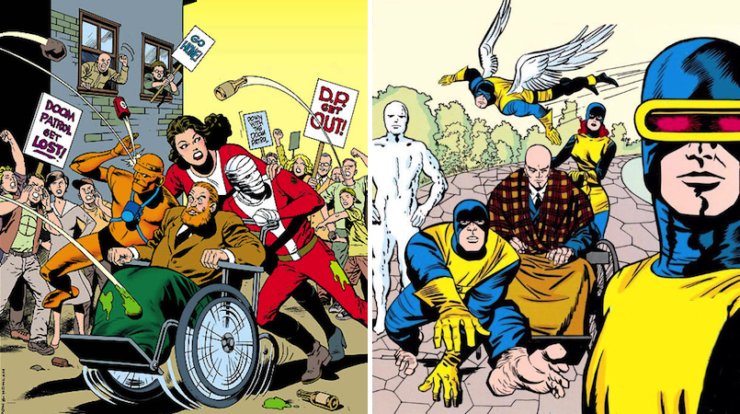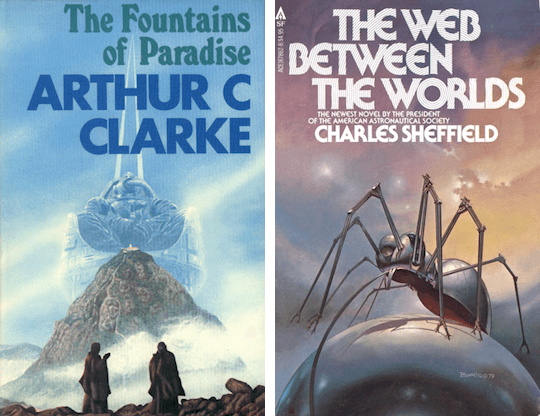An author has an epiphany, spots a story idea nobody ever had before, writes it in the white heat of inspiration, sends it off and gets a cheque in the mail. All is as it should be. At least, that is, until they discover someone else had the exact same idea at exactly the same time. Or worse—the other person’s version saw print first.
One of the more remarkable examples of this type of unfortunate concurrence occurred in 1979. Working on opposite sides of the planet in an era long before everyone had email, Charles Sheffield and Arthur C. Clarke wrote novels about…well, let me just quote Mr. Clarke’s open letter, which was reprinted at the end of Sheffield’s book…
Early in 1979 I published a novel, The Fountains of Paradise, in which an engineer named Morgan, builder of the longest bridge in the world, tackles a far more ambitious project—an “orbital tower” extending from a point on the equator to geostationary orbit. Its purpose: to replace the noisy, polluting and energy-wasteful rocket by a far more efficient electric elevator system. The construction material is a crystalline carbon filter, and a key device in the plot is a machine named “Spider.”
A few months later another novel appeared in which an engineer named Merlin, builder of the longest bridge in the world, tackles a far more ambitious project—an “orbital tower,” etc. etc. The construction material is a crystalline silicon fiber, and a key device in the plot is a machine named “Spider”…
The situation would have been one very familiar to Clarke, because not only did Clarke, Jack Vance, and Poul Anderson publish stories about solar sailing within a few months of each other in the early 1960s, Clarke and Anderson even used the same title, “Sunjammer.”
For that matter, poor Sheffield ran into a similar situation a few years later when he discovered while conversing with Robert Forward that Sheffield and Forward had more or less simultaneously hit on the idea of using as a setting binary planets orbiting so closely their Roche lobes overlapped.
What’s going on here? Did some service in Schenectady screw up and send the same letter to all of their subscribers?
As Clarke firmly asserted in his open letter, it’s not plagiarism. It is not even the homogenizing effect of a large coterie of authors writing to one editor’s very specific and well-known set of preferences, AKA the John W. Campbell, Jr. Effect1 . It’s something that must be a lot more frustrating from the perspective of authors: ideas whose time has come. Suddenly, authors decide to write about building orbital elevators2 . Or about solar sails. Or about collections of super-powered misfits led by men in wheelchairs.

Sometimes, it’s clear what was behind a cluster of stories—new discoveries, theories, and information driving thought and conversation toward a common point of inspiration. Whether directly or indirectly, Stephen Hawking’s “Gravitationally collapsed objects of very low mass” inspired Niven, Sheffield, and Varley, among others—thus “The Hole Man”, “Killing Vector”, and “The Black Hole Passes.” The effects of light pressure on the Echo satellites of the early 1960s may well have played a role in inspiring Vance, Anderson, and Clarke to write about solar sailing. Enthusiasm about space colonies combined with nuclear war-related anxieties are probably behind John Varley’s Gaia trilogy and Joe Haldeman’s thematically similar Worlds series. It’s not all that surprising when authors swimming in the same cultural pool, who subscribe to the same magazines, manifest parallel thought processes.
A lot of the time, though, causality is very unclear, and remains a mystery. The idea of orbital elevators had been around for twenty years (not counting Tsiolkovsky), so what was so special about 1979 in particular that two authors would decide to make orbital elevators the centerpiece of their novels? I have no idea. Maybe it really is that service in Schenectady getting its lines crossed.
Originally published in November 2017.
In the words of Wikipedia editor TexasAndroid, prolific book reviewer and perennial Darwin Award nominee James Davis Nicoll is of “questionable notability.” His work has appeared in Publishers Weekly and Romantic Times as well as on his own websites, James Nicoll Reviews and Young People Read Old SFF (where he is assisted by editor Karen Lofstrom and web person Adrienne L. Travis). He is surprisingly flammable.
[1]Which is why so many supposedly hard SF stories of a certain vintage feature awesome mind powers or reactionless drives. Those stories were inspired by the well-known scientific principle that the authors wanted to get a cheque from Campbell, and Campbell really liked stories that featured psionics and egregious violations of Newton’s Laws.
[2]It’s very apt that space elevators should have been independently embraced by two different SF authors, because the basic concept of space elevators was invented on at least four separate occasions of which I am aware: Tsiolkovsky in 1895, Artsutanov in 1959, Isaacs, Vine, Bradner, and Bachus in 1966, and Pearson in 1975. Clarke acknowledges Artsutanov and Isaacs in his letter but adds “There have since been at least three other independent “inventions” of the idea.” His phrasing leads me to think he’s not counting Tsiolkovsky, perhaps because Tsiolkovsky’s version could not have worked. If he includes Pearson as one of the three, there are at least two more inventions of the orbital tower of which I am not aware.











Did both books have to move Sri Lanka in order to make it work, or just Clarke’s?
Loved the last line of Clarke’s.
Happens with movies, too. Deep Impact and Armageddon. Antz and Bug’s Life. Innocent coincidences, apparently.
Unlike DS9 and Bab5. Much less innocent there we think…
Parallel invention happens not just in SFF but in real science; Leibniz–Newton, Darwin – Wallace and Elisha Gray – Alexander Graham Bell among many others.
Sometimes all the ingredients are there just waiting for someone to stir them together.
Then there’s Warbreaker (Sanderson) and Black Prism (Weeks) both writing a novel with color-based magic systems in the same year.
@1
Clarke did not need to move Sri Lanka. He just wanted to. IIRC Sheffield did not. OTOH, Clarke’s construction technique seemed a lot less heart-stoppingly terrifying than Sheffield’s.
@2 Give it a rest with the DS9 copied Babylon 5 allegation, nobody thinks that anymore.
I believe Sheffield’s elevator was anchored near Quito, in Equador.
1) There was a report many years ago of monkies on two widely separated islands simultaneously showing the same new practice of dipping food into salt water to add flavor (matching what they got from human food left behind?). Zeitgeist?
2) Yes we still know DS9 stole from BY. But Hollywood has completely different animals.
Abyss, Leviathan, and DeepStar Six all came out in 1989. I often wondered if there was some hanky-panky going on regarding at least Leviathan & DeepStar Six, but never bothered to find out.
I recently watched a TV show where the lead kills a bunch of violent religious fanatic aliens. One of them swears bloody vengeance, impersonates a human with the surname “Tyler”, and eventually enters a romantic relationship with the lead. When the deception is revealed, the lead lets the alien go back to their homeworld. That description works for both the first season of Star Trek Discovery and the second season of The Orville.
Another great example would be DC’s Swamp Thing and Marvel’s Man Thing, the almost simultaneously appearing muck monsters. To make “things” even stranger, the respective writers, Gerry Conway and Len Wein, were roommates at the time, although both claimed ignorance of the other’s work.
One potential explanation is that, countless coincidences being possible, some coincidences are inevitable, no matter how improbable any given one may seem.
I, however, hope the real explanation is Morphic Resonance.
I used to tell my wife that I discover a competitive idea for one of my scripts every Tuesday. Well, yesterday was a Tuesday and I discovered that my evil scientist is also named Morgan (damn you, Clarke!). Never read Fountains of Paradise, but maybe I’ll take a look after I finish my space elevator script/novel.
Quite a bit further than that, actually. Centrifugal force upward is greater than Earth’s gravity downward only for that part of the mass of the SE that’s above geosynch, and you need a lot of it to hold up all the mass below geosynch. Hence you have a cable much, much longer than 35,786 km or just a longer cable with a large mass at its end. It’s going to be at least 65,000 km.
Also, the Earth anchor doesn’t have to be right on the equator, though more than 20° north or south can cause problems.